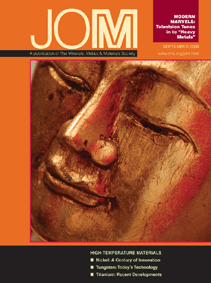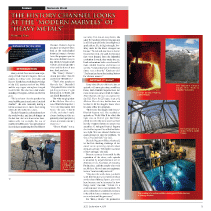 LATEST ISSUE |
||||
TMS QUICK LINKS: |
• TECHNICAL QUESTIONS • NEWS ROOM • ABOUT TMS • SITE MAP • CONTACT US |
JOM QUICK LINKS: |
• COVER GALLERY • CLASSIFIED ADS • SUBJECT INDEXES • AUTHORS KIT • ADVERTISE |
|
| Feature: Materials World | Vol. 58, No.9, pp. 12-15 |
The History Channel Looks at the
"Modern Marvels" of "Heavy Metals"
Maureen Byko
| ||||||||||||
| ||||||||||||
| ||||||||||||
|
|
||||||||||||
Questions? Contact jom@tms.org. © 2006 The Minerals, Metals & Materials Society |
|
Heavy metals have never been a specialty of Beth Dietrich-Segarra. Her two majors in college were television and history. Yet she has a working knowledge of the U.S. uranium rush of the 1950s and the way copper wiring has changed modern life. She also has a fair understanding of weapons, rubber, and bubble gum.
“Did you know that the powder that coats bubble gum is made out of crushed marble?” she asks randomly during a lull in a conversation. Just a fascinating tidbit she felt inclined to share.
Dietrich-Segarra is curious about how the world works, and her job hinges on the fact that she’s not alone in her fascination with, for example, the use of marble in bubble gum. Vice president of historical programming for The History Channel, Dietrich-Segarra is executive producer of Modern Marvels, a weekly look at the technological genius and historical impact of everyday items. In June, the program spent an hour telling the stories behind heavy metals, providing Dietrich-Segarra and the episode’s viewers with not just the whats, but the whys and the hows of uranium, copper, iron, lead, and zinc. The “Heavy Metals” episode was shown just after “Ben Franklin Tech” and before “BBQ Tech.” “That’s what people come to Modern Marvels for,” Dietrich-Segarra said. “They don’t know what they’re going to get, they just know it’s going to be good information, well told, and in a form they can distill themselves.” The wide-ranging ideas behind most of the Modern Marvels episodes arise out of Dietrich-Segarra’s need to know. “I’m very fascinated with how things work,” she said. “I like learning about all this, and what’s really great is I’m always looking at this as a novice. We get really smart people to produce these shows, and even smarter people as our resources.” “Heavy Metals” was a spinoff of an earlier, metals-themed episode. That show began in Dietrich-Segarra’s gym. “It was in the winter, and somebody had hung up their jacket. The coat said ‘titanium’ on it,” Dietrich-Segarra said. “I thought, ‘what the hell is titanium?’” She posed that question to her staff, who found numerous, fascinating stories about metals. And an episode was born. Regardless of the subject matter—whether it’s snack foods, weaponry, or heavy metals—common threads can be found in each episode of Modern Marvels. “Our shows generally feature technology and human ingenuity,” said Corrie Kaufman, associate producer of the “Heavy Metals” episode. Kaufman works for Actuality Productions, which has produced more than 300 episodes of Modern Marvels for The History Channel. The show has been in production for 11 years. “We like to profile cutting-edge technology, how things work, and find topics with current applications,” Kaufman said. In addition, a topic must have a colorful background or the show would be little more than a science lesson. “If it has a deep and interesting history it really helps with the storytelling,” Kaufman said. Arsenic, for example, was considered for the “Heavy Metals” episode because it has a fascinating history, but was ruled out because finding current footage would be difficult. “There aren’t too many companies working with it, so there’s nothing to film,” Kaufman said.
The production company settled on five metals with that winning combination of historic interest and current applications. Copper, Kaufman said, was chosen because it is the earliest metal worked by humans and remains in wide use today. Iron was an easy choice, she said. “It was discovered so long ago and is still being used for the latest high-tech applications, like in high-strength, low alloy steels for the latest, strongest car frames.” Nickel and zinc have a shorter history than iron, she said, but because they were integral from the industrial revolution forward, they made the cut. Lead and uranium both were chosen for their colorful histories and impact on society. “Lead, going back to the Roman times, was a shoe-in,” Kaufman said. “And uranium has a fascinating history for obvious reasons.” Every time Modern Marvels airs an episode with an engineering or military focus, Beth Dietrich-Segarra faces her most meticulous viewer of all: her father. Alan Dietrich, who was an engineer for the U.S. Navy for 25 years, is an avid Modern Marvels fan, but he does not hesitate to let his daughter know when he spots a flaw in a program. “He loves to find niggly little issues,” Dietrich-Segarra said. She recalled an episode on World War II in which the topic was an 18-inch gun. Her father called her after the show aired and told her the weapon shown on screen was actually a 16-inch gun. Dietrich-Segarra checked her tape and found that her father was right. She was amazed that he was quick enough to spot the problem. “It was a 3-second shot,” she said. Dietrich-Segarra will face what could
be the fact-checking challenge of her
career on an upcoming episode about
deep-sea salvage. “My father was head
of navy salvage,” she said. “Anyone who works here, you don’t
work here because you want to produce
stories about Britney Spears, you work
here because you’re interested in how
things work,” she said. “I think it’s a
combination of interest and aptitude. We
are not chemists or scientists, but we have
to be able to have an interest in order to
even understand the processes.” Manos, who teaches, among other classes, a freshman seminar called “The Shape of Things,” has used Modern Marvels more than once to illustrate technological processes, applications, and impacts on society. “My seminar is about basically one thing: open your eyes and ears and look at the world closely and ask yourself how did it come to be that way,” he said. Modern Marvels follows the same theme, Manos said, excelling at showing viewers science and technology from a new point of view. The way Modern Marvels presents information on a topic is fascinating to Manos. Most topics are so broad that the possible storytelling angles are endless. Manos likened the scenario to mapping a route from Miami to Seattle. The beginning and end points are fixed, but the travel routes can vary infinitely. Often, he said, when a program covers a topic about which he has knowledge, the route taken is entirely different than one he would have chosen. “In a show like Modern Marvels, I find that entertaining and interesting and engaging,” he said.
The “Heavy Metals” show followed a story arc that began in space, with exploding meteors sending heavy metals catapulting to the earth. And it ended in space, with those same metals coating the Apollo moon lander in the form of a nickel alloy. In between, the viewers were taught the basics on the periodic table, where heavy metals fit into that table, and how heavy metals are formed. Just when the program risked becoming a video textbook, it moved on to discuss uranium, visiting a nuclear power plant and telling the story of the U.S. uranium rush of the 1950s, when the government paid average folks to purchase a Geiger counter and hunt for uranium in the West. Other storylines touched on the value of copper in ancient weapons and how it is mined and processed today; the development of the Bessemer converter; how lead is mined and how it was used by ancient Romans to flavor foods and drinks; the benefits of galvanizing steel with zinc coatings; and the many attributes of nickel alloys and their role in modern aviation. All in all, not the path Manos would have mapped out, but one he enjoyed, for the most part. His only objection, he said, was the emphasis on lead’s prominence in Roman society and the implication that it played a role in the downfall of that civilization. “I think it somewhat overrated the impact on the Roman Empire,” he said. Although Manos played the role of expert in this episode and did not actually learn any new material, he still enjoyed the presentation. “There’s a certain joy that comes from reaffirmation and seeing what you know pieced together into a particular narrative,” he said. Certainly, television has its low points, and that fact does not escape Manos, who mourns the decline of hard news on the evening news. But, despite his disenchantment, he will not turn away from the medium altogether. “For academics to abandon it is much to your peril,” said Manos, who has met his share of professors who bragged that they did not own televisions. “Embrace it and work to change it. When asked, get involved in the conversation.” Modern Marvels, he said, is an example of the good that television can do. It offers people who have no scientific career aspirations a bit of science in a manner that is palatable and a venue that is comfortable for them, and the world is a better place for it, Manos believes. “I believe that the ability to use this medium, which has this multiplicity of access to the mind through sight and sound coupled with moving images, has the potential to educate and enlighten,” Manos said. A populace with an understanding of how the world works is more suited to determine how resources should be allocated, he said. Beth Dietrich-Segarra considers herself an average viewer of Modern Marvels— someone with little expertise in a particular subject area, but an interest in learning. “If I have a question, it’s pretty much what my audience would question. That’s what people come to our show for, and our network as whole, to get answers they understand.” As a result of Modern Marvels, she
and the program’s viewers have at least
a grasp of the basic science behind
everything from snack foods to land
mines to the Lake Pontchartrain Causeway. Maureen Byko is managing editor of JOM. |








